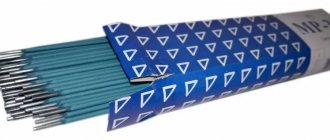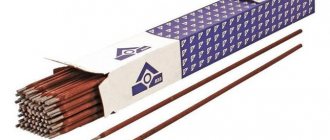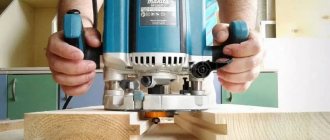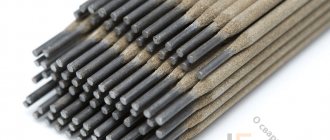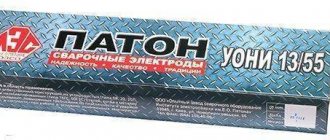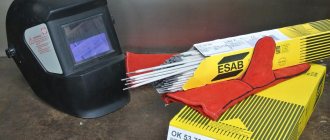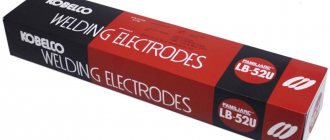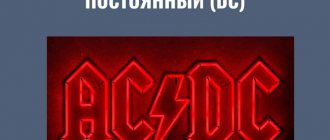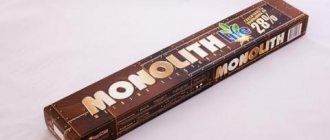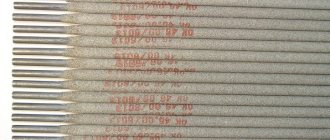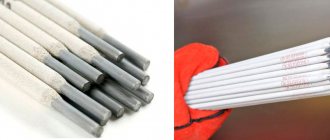Features of cast iron
Unlike steel, cast iron contains a significant amount of carbon - from 2 to 6%, while CO2 is in a free state - in the form of graphite. This determines its unique characteristics - it is extremely hard, but at the same time fragile, has low ductility and viscosity. These properties affect the processing and welding of metal. If the parameters, materials and welding techniques are incorrectly selected, the following risks exist:
- due to the presence of graphite in the metal, cracks may form;
- carbon burns out, which leads to the formation of pores in the weld;
- Refractory oxides are formed, whose melting point is higher than that of cast iron.
In addition, difficulties during welding can be caused by such a property as high fluidity, which prevents the formation of a high-quality seam.
Rapid cooling of gray cast iron after a heating temperature of more than 750°C leads to the transformation of graphite into iron carbide - cementite. The cast iron itself turns from gray to white. Such cast iron cannot be welded.
Electrode grades for cast iron
These features require the selection of special brands of electrodes. They must provide the same concentration of CO2 in the base and filler metal and the same cooling time. Electrodes for cast iron often include copper (copper-nickel, copper-iron electrodes), but they can also be steel, ferro-nickel or nickel. The type of rod coating is basic, less often acidic. Among the most popular grades that are used for welding on cast iron are MNCh-2, OZCh-4, OZCh-6, OZCH-2, OK 92.18, OZZHN-1. Some of them are universal in purpose, allowing you to work with all types of cast iron (except for the white one mentioned above), some have a narrower specialization (more on this below).
| Electrode brand | Cast iron type | Welding direction | Welding type | Properties |
| MNC-2 |
|
|
| Preferred for welding the first layer in joints that require high joint density and surface cleanliness after processing |
| TsCh-4 |
| in the down position |
| For structures made of ductile iron with nodular graphite and gray cast iron with flake graphite, as well as their combinations with steel. |
| OZCH-6 |
|
|
| For manual arc welding and surfacing of thin-walled parts. |
| OZCH-4 |
|
|
| They are preferred when welding the last layers, providing the weld metal with high abrasion resistance and impact strength. |
| OZCH-2 |
|
| cold welding | For welding, surfacing and welding of casting defects when restoring cast iron products. |
| OZZHN-1 |
|
| cold welding | This grade is often used for welding large casting defects and multi-layer surfacing with large volumes of metal. |
| OK 92.18 |
| all provisions | hot welding | They have proven themselves well in the repair of products made from thin parts (welding damage and defects in gearboxes, pump housings, engine blocks, etc.). |
Labeling principles
The brands of electrodes for manual arc welding indicate the main performance qualities of the consumables used. An example of marking is E46-LEZANO-21-F-UD E 43 1(3) – RC13. Decryption is carried out as follows:
- E46 – designation of the type of electrodes. As previously noted, classification is carried out according to purpose. In this case, the consumable material is intended for carbon and low-carbon steels.
- LEZANO-21 is the brand indicated by the manufacturer. This part of the marking does not carry information about the performance of the electrodes.
- F is a symbol intended to indicate diameter. The absence of any number indicates that the diameter value is displayed elsewhere.
- U - the symbol in the marking indicates the possibility of using consumables for working with carbon and low-carbon steels to produce a weld with a power limit of up to 588 MPa.
- D is a symbol used to determine the thickness of the coating used. In the case under consideration, the coating is thick.
- E is a symbol associated with the international classification system for materials used as coatings.
- 43 – part of the marking is used to indicate the tensile strength (430 MPa).
- 1 – relative elongation, which is 20%.
- (3) – part of the marking that is used to indicate the temperature required to achieve a specific viscosity of at least 34 Dm/cm2. In this case, the indicator is 20 degrees Celsius.
- RC - symbols indicating the type of coating (rutile-cellulose).
- 1 – symbol defining the permissible spatial position.
- 3 – group of consumables for welding, which is characterized by a certain current and voltage at no load.
In order to decipher the markings, you should use reference literature, which contains all the necessary tables.
Hot welding of cast iron
Hot welding is welding that requires pre-calcination of the cast iron.
Actually, the “hot” method is the one in which the metal is heated to a temperature of +500... + 600 °C, “semi-hot” - the temperature reaches +300 +400 °C, “warm” - +200 °C. Most often, universal electrodes of the TsCh-4 brand are used for this, as well as OK 92.18 (“warm” method) and OMCh-1. Also in this case, electrode rods of the UONII, ANO brands, carbon and other electrodes are used.
Marking of electrodes for manual arc welding
The ability to read labels is necessary for anyone who deals with technology. Electrodes use alphanumeric names, each part of which indicates certain characteristics. Let's take, for example, the marking E46-ANO-4-F-UD E 43 0(2)-P25. Don’t forget, every self-respecting welder should know the marking of electrodes for manual arc welding!
- E46 . Type. This type of electrode is designed for working with low-alloy and carbon steel. The number 46 here means tensile strength: 46 kg per 1 square millimeter of welding section.
- ANO-4 . This part is a regular trade designation, brand, and does not say anything about the technical characteristics of the product.
- F. _ A symbol that represents the diameter, expressed in millimeters. The diameter itself is indicated somewhere else.
- U. Shows that the electrode can weld low-alloy and carbon steels having a tensile strength not exceeding 451 MPa.
- D. _ Coating thickness. As we found out earlier, this letter means that the coating is thick, up to 80% of the electrode diameter.
- E. _ According to international standards, this letter indicates that the electrode is consumable and has a coating.
- 43. Tensile strength. In this case it is 430 MPa.
- 0. Relative extension. Zero here can be interpreted as an elongation of less than 20%.
- (2). The minimum temperature at which the viscosity of the weld metal is at least 34 Joules per square centimeter. This marking indicates 2 – 0°C.
- R . A type of coating. Here we are dealing with rutile coating.
- 2.Spatial position of the rod. You can weld from any position, with the exception of working along a vertical seam from top to bottom.
- 5. Welding current and connection. In this case, both direct and alternating current of any polarity are allowed for operation at an open circuit voltage of 70V.
For such large markings, it is very difficult to remember the meaning of each of the segments, so it is useful to have reference books on hand that contain the necessary data. It is better, of course, to remember the markings of electrodes for manual arc welding, so as not to waste time working with reference materials.
Recommendations for choosing electrodes
Do not forget about safety precautions; at your leisure, you can read about why you should not watch welding without a welding helmet.
Administration
Knowing the basic characteristics of electrodes, we can navigate their diversity and find exactly what is needed for a specific job. What should you pay attention to when selecting consumables?
- Metal that will be joined by welding. Most often this is structural low-carbon steel, for which domestic grades of electrodes OZS-12 and ANO-4 are suitable. If you need to cook stainless steel, then you should pay attention to the Russian TsL-11 or imported OK 63.34 and OK 61.30.
- Features of the parts to be connected. The choice of coating depends on this. If the surface is clean, then the best coating will be rutile (electrodes brand MP-3), it makes it easy to obtain an electric arc, has a small spread of splashes and is recommended for both beginners and professionals. Cellulose and base coatings are used to create particularly strong joints, but require direct current for welding. An acid coating removes pores from the seam and works against rust, but its fumes are harmful to the health of the welder.
- Thickness of the metal being welded. This determines what electrode diameter to choose and what current to set.
Correlation between electrode and metal characteristics
The ratios of metal thickness, electrode diameter and current supplied from the inverter are usually indicated in special tables. Such a table can usually be found on the box with welding consumables. In general terms, this relationship looks like this:
- with a current strength of up to 50A (home inverters), you can weld metal 1-2 mm thick with electrodes with a diameter of 1-2 mm;
- with 80A you can safely cook workpieces 3 mm thick, and the electrode will also be 3 mm in diameter;
- 100-200A it is permissible to weld metal up to 8 mm with electrodes having a diameter of 4 mm;
- 160-200A (semi-professional transformer) allows you to weld parts 9-12 mm in thickness with 5 mm rods;
- 250-350A (professional devices) and electrodes with a diameter of 8 mm or more weld workpieces with a thickness of more than 16 mm.
MNC-2
Universal nickel-copper electrodes that allow you to work with any type of cast iron - malleable, gray and high-strength. Products of this brand are specially designed so that welding can be performed without pre-calcination. The core is made of monel metal (mostly nickel, 28.5% copper, iron and manganese are also present) has a special coating. Main purpose: cold welding, surfacing, welding of casting defects. Welding is possible in any spatial position except the ceiling and from top to bottom, and is carried out with direct current of reverse polarity. In addition to versatility of use, there are a number of advantages:
- no need for calcination - minor heating is required only when working with thick products;
- easy ignition, stable arc combustion, high melting rate at a relatively low temperature, easy separation of the slag crust;
- excellent quality of the resulting seam in terms of strength, ductility, corrosion resistance;
- color identity of the base and deposited metal;
- low hardness of the seam, due to which during operation of the structure the risk of cracks in the joint area is minimal.
This brand of cast iron electrodes for electric arc welding is widely used in the repair of worn parts in gears, pumps, gearboxes, excavator buckets and other components and mechanisms. Analogues of the MNC-2 brand according to the international classification are electrodes of the ENiCu-B type.
Important. If multi-layer surfacing is carried out, the bead must be gradually cooled to a temperature of 60 ° C and forged with light blows of a hammer. This reduces the internal stress in the metal structure and reduces the risk of cracks appearing in the heat-affected zone. The length of the welding roller itself is from 30 to 50 mm.
Separation by coverage
The classification of electrodes for manual arc welding allows them to be differentiated according to many characteristics. One of the most common is what kind of coating these consumables have. The coating of electrodes for manual arc welding is often decisive when it is necessary to decide on their purchase.
Types of electrode coatings for manual arc welding have divisions:
- Rutile . This element is titanium dioxide. With this type of coating, metal spattering is reduced, fluidity increases, and a thick layer of slag is formed, which can then be easily separated. However, the risk of formation of defects such as pores is high. It is advisable to use it for connecting parts of small thickness made of low-carbon steel.
- Pulp . In addition to the cellulose itself, the coating contains silicon and magnesium. This coating increases gas formation, which reliably protects the weld pool. The spatterability of the metal is increased. It is convenient to weld vertical seams, but one cannot expect an aesthetic appearance.
- Basics . The main elements are derivatives of calcium and magnesium. This provides high mechanical strength. The weld metal is chemically pure. The big advantage is the ability to weld in any position. Can be used for welding critical structures.
- Sour . They are used only for making horizontal seams. There is a risk of cracks and undercuts. May pose a health hazard to the welder.
Each type has its own designation. Rutile coating is designated by the letter “R”, cellulose by the letter “C”. If the coating is a mixed type of rutile and cellulose, then two letters “RC” are used.
The base coating has the letter “B”, which means base. Acid coating is assigned the letter "A". The letter “P” denotes other coatings. The letter “C” means that we are talking about a special coating, with which it becomes possible to carry out the process under water.
OZCH-4
In terms of their properties, these electrodes with a basic coating are almost as universal as the MNCh-2 brand - they can be used to weld any type of cast iron. Electrodes make it possible to obtain a seam with increased wear resistance (which is important if the operation of the product involves constant friction of metal on metal), as well as high manufacturability during cutting and high resistance to impact loads. For welding and surfacing, reverse polarity current is used. Possible spatial positions are lower and vertical. When welding technology, one must comply with the requirements for products of the MNCh-2 brand (cooling and easy forging of the roller), however, unlike MNCh-2, in this case, preliminary calcination for an hour is required at a temperature of 250...280 °C.
Important. OZCH-4 electrodes are most effective when welding the last layers, providing the weld metal with high abrasion resistance and impact strength.
Rating of the best models of welding electrodes
We suggest that you familiarize yourself with the rating of electrodes with rutile coating.
This category includes:
- Esab scel ok 46. Electrodes coated with rutile-cellulose coating. This model is considered one of the best for welding work. Thanks to it, it is possible to quickly ignite the arc, as a result of which a dense seam is formed.
- You can work with such models on welding machines with alternating current. Electrodes do not form a large volume of slag during combustion. When working with rusty metal, additional cleaning from corrosion will be required;
Lincoln electric Omnia
These electrodes belong to an American company. They have been producing quality products for 100 years.
- For the first time they managed to produce an electrode with high-quality coating in 1928.
- Long-term development was not in vain. The company produces the best rutile-cellulose electrodes, which are popular among professional and novice welders.
- The affordable price makes the model in demand among professionals. During the combustion process, a small amount of sparks appears, which can cause inconvenience when installing parts.
- When the electrode melts, a small amount of slag appears. This model can be used on rusty and dirty metal surfaces. Technicians prefer to use omnia to work on the pipeline network;
Special electrodes
This brand is produced in Russia. They are specifically certified to perform welding work on mild steel.
- The main advantage of this model is that it produces an even and light seam. After cooling, a thin crust of slag appears on the surface.
- Rutile electrodes from this manufacturer cope well with climate disasters and temperature changes.
- The surface of the metal seam does not crack or deform. The coating of this model is very sensitive to humidity;
Resanta mr-3
This model of electrodes is considered popular and in demand. However, specialists do not often choose a similar brand for welding work.
The fact is that these products are inferior in all operational characteristics.
- During work, slag pits may appear. During use, a chemical reaction occurs with increased crystallization, resulting in the formation of large amounts of carbon.
- The advantage of this type is the rapid ignition of the arc and the ability to work on electric welding equipment with direct and alternating current.
The main disadvantage is the possible deformation of the seam after it cools.
TsCh-4
Basic coated electrodes designed for both hot and cold welding of ductile, ductile and gray cast irons. The main purpose is welding of defective castings, surfacing when repairing cast iron parts. These are also electrodes for cast iron and stainless steel; they allow high-quality welding of these two alloys with different structures. Often, to obtain a more effective result, they are used only for surfacing the first layers, after which it is performed with other, special electrodes.
Purpose
The letter “U” in the marking of electrodes means that they are applicable to carbon steels, including low-alloy steels. The letter “L” means that the electrodes are intended for connecting products made of alloy steels, which have increased strength.
For structural high-alloy steels, electrodes with the letter “B” are applicable. For heat-resistant alloy steels, electrodes with the designation “T” are used. For alloys with special properties, in particular for surfacing, consumable elements designated “H” are used.
OZCH-2
These are copper electrodes for welding cast iron (copper core) with an acid coating. They have a limited scope of use - they are used only for working with malleable (soft and viscous) and gray cast iron. The scope of work includes cold welding, as well as surfacing and welding of casting defects when restoring cast iron products. The length of the roller that is recommended for welding is small, in the range of 30... 50 mm. The resulting roller must be cooled to 60 °C and then forged with gentle hammer blows. Before welding, the electrode should be calcined for an hour at a temperature of 190-210 degrees. Welding is permissible in the lower and vertical positions with direct current of reverse polarity.
Electrodes for welding alloy steels
Home / Library / Welding materials / Electrodes for welding alloy steels
The group of grades of electrodes for welding alloy steels is much less numerous compared to the group of electrodes for welding carbon and low-alloy steels. This is mainly explained by the fact that of all types of coatings for alloyed electrodes, only coatings of the basic type or, in rare cases, of the rutile-basic type are used. In addition, the development of an alloyed electrode that provides a set of operational and welding-technological properties is almost always a complex engineering task, the solution of which requires large material and time costs.
The most important characteristics of a group of electrodes for welding alloy steels : chemical composition of the deposited metal; strength and viscoplastic properties of the weld metal, as well as special properties of the weld metal or joint. These indicators should be used when choosing the brand of electrodes for welding a specific alloy steel object.
The group of electrodes for welding alloy steels combines standardized GOST 9467-75 five types of electrodes for welding structural steels of increased and high strength: E70, E85, E100, E125, E150; nine types of electrodes for welding alloy heat-resistant steels: E-09M, E-09MH, E-09H1M, E-05H2M, E-09H2M1, E-09H1MF, E-10H1M1NFB, E-10HZM1BF, E-10H5MF; a number of grades of electrodes contained in OST 108.948.01-86; electrodes according to individual specifications.
The chemical composition of the metal of welds made with electrodes of types E70 ... E150 is not standardized by GOST 9467-75 and may not be given in the regulatory and technical documentation for electrodes, with the exception of sulfur and phosphorus, the content of which should not exceed 0.030 and 0.035%, respectively. However, the technical documentation for electrodes corresponding to the specified types always contains data on the chemical composition of the deposited metal, which most often is an acceptance characteristic of the electrodes. If such data is not included in the acceptance characteristics, but is given as a reference (typical chemical composition of the deposited metal), they must be taken into account when choosing the brand of electrode for welding a particular alloy steel object.
Welds at nuclear power facilities must have increased reliability. Therefore, only certain brands of electrodes that have passed special certification tests can be used for these purposes. In accordance with the document “Basic provisions for welding and surfacing of components and structures of nuclear power plants, experimental and research nuclear reactors and installations” OP 1513-72, the following grades of electrodes are allowed to be used for welding alloy steels: TsU-2KhM, TsL-20, TsL-21 , TsL-38, TsL-45, TsL-48, PT-30, RT-45A, RT-45AA.
Electrode coatings of the main type provide the highest viscoplastic properties due to the lowest content of hydrogen, sulfide and oxide inclusions in the deposited metal compared to coatings of other types. This is the first of the main reasons why basic coatings are used for electrodes intended for welding alloy steels.
The second reason for using low-hydrogen coatings of the main type when welding alloy steels prone to cold cracking is the negative influence of hydrogen in the heat-affected zone of the products being welded. Atomic hydrogen diffuses from the weld metal into the heat-affected zone, where it is released into microvoids and pores existing in the base metal, formed from the fusion of dislocations that move under the influence of welding stresses. When released into voids, atomic hydrogen is converted into molecular hydrogen, as a result of which a pressure of the order of 105 MPa develops, and tensile stresses of the second kind arise in the surrounding volumes of the metal. Adsorption of hydrogen on the surface or at the tip of the formed microcrack is also possible. As a result of the development of these phenomena, the strength of the metal decreases and the likelihood of cold cracks in the heat-affected zone of the base metal increases.
Electrodes type E70 . ANP-2 electrodes are intended for welding steels 14Kh2GMR, 14Kh2GM-SSh, 14KhMNDFR, 14KhGNMD; the deposited metal is alloyed with nickel, chromium, and molybdenum. VSF-75U electrodes are intended for welding pipes and other critical structures made of alloy steels with a temporary resistance of 640-690 MPa. The deposited metal is alloyed with molybdenum and vanadium. K-5NMH electrodes are intended for welding alloy steels with a yield strength of 590-790 MPa, for example 14Kh2GMR. The weld metal is alloyed with nickel, chromium and molybdenum. LKZ-70 electrodes are designed for welding high-strength carbon and alloy steels (up to 690 MPa). The deposited metal is alloyed with chromium. Welding can only be done in the down position. VSF-85 electrodes are intended for welding fixed joints of thermally strengthened pipes made of alloy structural steels with a temporary resistance of 690-710 MPa. The metal is alloyed with nickel, chromium and molybdenum.
NIAT-3M electrodes are intended for welding steel grades 30KhGSA, 30KhGSNA, 25KhGSA, 20KhGSA, 12Kh2NVFA, etc. The deposited metal is alloyed with chromium and molybdenum. UONI-13/85 electrodes are intended for welding alloy steels with a temporary resistance of 690-980 MPa. The weld metal is alloyed with molybdenum. UONI-13/85U electrodes are intended for welding steels 35GS, 25G2S, 30KhG2S, etc. Welding is carried out using both direct and alternating current; the deposited metal is alloyed with molybdenum.
Electrodes N-20/Sv-12Kh2NMA-VI are intended for welding steels VNL-3M, 30KhGSA and their combinations in the lower and vertical positions. The weld metal is alloyed with nickel, chromium and molybdenum. OZSh-1 electrodes are designed for welding alloy steels with a temporary resistance of up to 1080 MPa. Electrodes N-17/EP331, N-17/EP331U are intended for welding cast steels 27KhGSNML, 35KhGSL and their combinations with steels 30KhGSNA, 35KhGA in the lower and vertical positions. The weld metal is alloyed with nickel, chromium, molybdenum and tungsten. Electrodes N-17/EP331-VI, N-17/EPZZ1U-VI are intended for welding cast steels 27KhGSNML, 35KhGSL and their combinations with wrought steels 30KhGSNA and 30KhGSA in the lower and vertical positions. The weld metal is alloyed with nickel, chromium, molybdenum and tungsten.
OZS-11 electrodes are intended for welding steels 12МХ, 15ХМ, 12ХМФ, 15Х1М1Ф and the like, operating at temperatures up to 510 °C, both on direct and alternating current. The weld metal is alloyed with chromium and molybdenum. TML-1U electrodes are intended for welding steam pipelines made of steels 12МХ, 15ХМ, 12Х1МФ, 15Х1М1Ф, 20ХМФЛ, operating at temperatures up to 540 °С, and heating surface elements made of steel grades 12Х1МФ, 12Х2МФСС and 12Х2МФБ. The weld metal is alloyed with chromium and molybdenum. TML-4V electrodes are intended for repairing defects in cast housing parts of turbines and steam fittings made of steels 20ХМЛ, 20ХМФЛ, 15Х1М1ФЛ, 12МХЛ, operating at temperatures up to 565 °С without subsequent heat treatment of the repaired areas. The weld metal is alloyed with chromium and molybdenum. TsU-2ХМ electrodes are intended for welding power equipment made of steels 15ХМ, 20ХМ, 20ХМЛ, operating at temperatures not exceeding 540 °С. The weld metal is alloyed with chromium and molybdenum.
TML-ZU electrodes are intended for welding steam pipelines made of steels 12Kh1MF, 15Kh1M1F, 20KhMFL, 15Kh1M1FL, operating at a temperature not exceeding 570 °C, and heating surface elements made of steel grades 12Kh1MF, 12Kh2MFB and 12Kh2MFSR, as well as for welding defects in elements made of the same steels The weld metal is alloyed with chromium, molybdenum and vanadium. TsL-20 electrodes are intended for welding steels 12Х1М1Ф, 15Х1М1Ф, 20ХМФЛ, 15Х1М1ФЛ and similar, operating at a temperature not exceeding 565 °С, as well as for welding casting defects. The weld metal is alloyed with chromium, molybdenum and vanadium. TsL-17 electrodes are intended for welding steel grades 15Kh5M, 12Kh5MA and 15Kh5MFA, operating in aggressive environments at temperatures not exceeding 450 °C. The weld metal is alloyed with chromium, molybdenum and vanadium.
PT-30 electrodes are intended for welding power equipment made of 10GN2MFAA steel, operating at a temperature not exceeding 350 °C. The weld metal is alloyed with manganese, nickel and molybdenum. Electrodes RT-45A and RT-45AA are intended for welding power equipment made of steels 15Х2НМФА and 15Х2НМФАA, operated at temperatures not exceeding 350 °С. The weld metal is alloyed with manganese, chromium, nickel and molybdenum. TsL-21 electrodes are intended for welding power equipment made of steel grade 16GNMA and similar, operating at temperatures not exceeding 400 °C. The weld metal is alloyed with manganese, nickel and molybdenum. TsL-38 electrodes are intended for welding power equipment made of steels 12ХМ, 12МХ, 15ХМ, 12Х1МФ, operated at a temperature not exceeding 585 °С. The weld metal is alloyed with chromium and molybdenum.
TsL-45 electrodes are intended for welding power equipment made of steels 12Х1МФ, 15Х1МФ and similar, operating at a temperature not exceeding 565 °C. The weld metal is alloyed with chromium, molybdenum and vanadium. TsL-48 electrodes are intended for welding power equipment made of 16GNMA steel and other manganese-nickel-molybdenum steels operated at temperatures not exceeding 400 °C. The weld metal is alloyed with nickel, molybdenum and vanadium.
TsL-57 electrodes are intended for welding power equipment made of steel 10Х9МФБ and similar ones, operating at a temperature not exceeding 350 °C. The weld metal is alloyed with chromium, molybdenum and vanadium. TsL-59 electrodes are intended for welding power equipment made of 10GN2MFA steel, subjected to normalization or hardening and tempering, operating at a temperature not exceeding 350 °C. The weld metal is alloyed with nickel and molybdenum.
| ← Electrodes for welding and surfacing of cast iron | Electrodes for welding carbon and low-alloy steels → |
Share link:
OZZHN-1
Area of use: exclusively cold welding. A constant current of reverse polarity is used. The types of cast iron to be welded are ductile and gray. Before welding, the electrode must be calcined for an hour at a temperature of 350°C. As is the case with other grades of cast iron, the bead should be forged with light blows of a hammer to relieve internal stress in the weld metal. This grade is often used for welding large casting defects and multi-layer surfacing with large volumes of metal. In the latter case, these electrodes must be combined with MNCh-2 or OZCh-3 (the first and intermediate layers are fused with them).
Features of working with electrodes for manual arc welding
When working, remember that electrodes must meet certain standards:
- ensure minimal splashes during operation;
- create a strong, reliable connection;
- maintain a stable electric arc;
- ensure chemical compatibility with the material being joined;
- create conditions for high-quality sutures;
- maintain resistance to the influence of the external environment;
- do not emit highly toxic gases that can harm the health of the welder;
- The melt should evenly cover the surface of the seam.
Welding polarity
Connecting the electrode also has its own nuances.
- To weld thick materials, use a direct polarity connection, when the electrode is connected to the negative terminal of the inverter, and the part to the positive terminal.
- For thin sheets, it is better to use a reverse polarity scheme, when the electrode is connected to the anode, and the part is connected to the minus.
All this can be attributed to the peculiarities of working with electrodes for manual arc welding. Of course, we must not forget about safety precautions. Before performing manual arc welding, it is necessary to learn the rules of electrical safety, and during work have professional protective equipment:
- welder's mask with special glass;
- protective suit;
- shoes without open lacing or boots;
- fire-resistant gloves or leggings.
OK 92.18
The new name for these electrodes is OK Ni-Cl. They have a base coating with a high graphite content. Designed for welding with minimal heating. They operate on both direct and alternating (at the same time reduced) currents. They have proven themselves well in the repair of products made from thin parts (welding damage and defects in gearboxes, pump housings, engine blocks, etc.). Answering the question of which electrodes are suitable for welding cast iron and steel, we note that along with TsCh-4 these are also suitable.
Other selection options
A few more parameters that determine the choice of electrodes for welding. One of the most important indicators is the polarity of the connection, and accordingly the type of current.
If an inverter is used for welding, then you need to understand that it produces direct current. Therefore, connecting the electrode for welding can be done according to two schemes.
- Polarity is straight. The diagram is as follows: minus is connected to the welding electrode, plus to ground.
- The polarity is reversed. Here it’s the other way around: minus to the mass, plus to the holder.
What are the features of each connection scheme? It all depends on the strength of welding of metals. With direct polarity, the metal parts being welded are subject to high heat. With reverse polarity, the heating temperature is not so high. Therefore, when you need to weld two metal sheets of small thickness, it is better to use reverse polarity, which will provide protection against burn-through. In addition, reverse polarity is used when welding products made from high-alloy steels. They are sensitive to high temperatures.
There are three more indicators that you need to pay attention to.
Welding thickness
The diameter of the electrode must be related to the thickness of the parts being welded. That is, these two parameters are interconnected. Here are some ratios.
| Diameter of welding material, mm | Thickness of welded parts, mm |
| 2,5 | 2 |
| 2,5-3 | 3 |
| 3,2-4 | 4-5 |
| 4-5 | 6-12 |
| 5 | 13 |
It is important to choose an electrode by diameter. The thing is that the higher this indicator, the worse the density of the seam, taking into account the ratios in the table. In addition, incorrect selection leads to instability of the welding arc, deterioration of penetration, and an increase in the width of the seam itself.
Another dependence of the diameter of the welding electrode. In this case, it depends on the current strength.
| Diameter of welding material, mm | Welding current strength, A |
| 2 | 55-65 |
| 2,5 | 65-80 |
| 3 | 70-130 |
| 4 | 130-160 |
| 5 | 180-210 |
| 6 | 210-240 |
It turns out that three parameters: current strength, thickness of the metals being welded and electrode diameters are interconnected. Therefore, when answering the question of which electrodes to choose, it is necessary to take this relationship into account. However, we note that the current strength in each category may differ slightly from those presented in the table. MR electrodes with a diameter of 2 mm can be welded at a current of 40 A. SSSI at 30 A. Therefore, before choosing electrodes, be sure to study their characteristics, which are indicated by the manufacturer on the packaging of the welding material.
Types of metals to be welded
Selecting welding materials for the required metals is not always easy, because by eye you can only determine steel, stainless steel, cast iron or non-ferrous metal. It is clear that in addition to steel structures where the electrodes described above are used, in all other cases special welding products are used: for cast iron, for stainless steel, for aluminum and so on.
As for steel products, there are certain difficulties depending on the definition of the type of steel. But if you figure this out, then the question of how to choose the right electrodes will become easier to answer.
- For welding boiling-type steels, you can use any grade with any coating. These steels include: low-carbon and slightly deoxidized.
- For welding semi-quiet steels, it is better to use electrodes with rutile or basic coating.
- For welding structures made of mild steel, which are subject to high dynamic loads, and which are operated at fairly low sub-zero temperatures, it is better to use grades with a basic coating.
The quality of the weld will also be affected by the stability of the arc. Therefore, the electrode you choose must match the type of current you are using. For welding consumables with a basic coating, only direct current is required; for other types, both direct and alternating current can be used. For electrodes with rutile, cellulose and acid coating, which operate from welding transformers, that is, on alternating current, the arc burns stably. This means the seam is of high quality.
As for the welding direction, cellulose-coated electrodes are welded well in the lower position and vertically. Because these electrodes produce a fairly viscous slag and plus the metal of the wire is transferred to the seam in small drops, which allows you to evenly fill the joint between the metal parts. In this regard, the worst weld seam is formed on electrodes with a basic coating.
When there is a question of welding thick-walled products, the technology determines the multilayer nature of the applied seam. Therefore, such a parameter as good slag separation becomes the main one when choosing electrodes. In this regard, electrodes with basic coating again lose out. Let us also add here that welding products of this type require a certain purity of the metals being welded.
How much do electrodes cost for cast iron?
The main factors that determine the cost of this consumable are the brand and country of origin, the type of electrodes, their brand and coating composition. Traditionally, high-quality European and American analogues are considered more expensive - for example, products from such well-known brands as ASPIK or UTP. Excellent consumer properties when working with cast iron are demonstrated by the German-made UTP 86 FN electrode and also by German Capilla brand products. Russian analogues are cheaper, while the quality of modern domestic products is at a high level.
What to consider when choosing welding electrodes
Before purchasing an electrode for welding equipment, you must adhere to several simple criteria, which are as follows:
- Product diameter. In this case, it is important to consider the thickness of the metal elements. Don't forget about the power of welding equipment. An electrode with a diameter of 3 mm is considered a universal model;
- Protective covering. The choice of coating directly depends on the purposes for which the consumable will be used. The main function is to protect the metal core inside the electrode. During the heating process, a protective base is formed between the electrode and the iron elements, preventing the release of slag. Some types of electrodes contribute to the appearance of slag pits, which lead to weld deformation;
- Product brand. Most electronic products quickly weld low-carbon and low-alloy steel products. To carry out work on the surface of stainless steel or alloyed metals, you will need to use special types of consumables;
Storage conditions. Different types of protective coating can absorb moisture in different amounts. As a result, the metal seam may become brittle. In addition, difficulties may arise with igniting the arc.
The use of such electrodes is considered unprofitable. Experts recommend storing a pack of welding consumables in a dry place;
Manufacturers. Domestic companies offer a good selection of electronic products. They are capable of producing high-quality seams.
Where can I buy electrodes for cast iron?
You should buy such products only from well-known manufacturers and trusted suppliers - this is a guarantee of high factory quality and brand reputation. This is precisely the high quality of cast iron electrodes produced by one of the oldest specialized enterprises in Russia – the Magnitogorsk Electrode Plant.
On our website you can buy products at the manufacturer's price. Depending on the brand, the material is perfect for both welding and restoration surfacing. The products have GOST R and sanitary-epidemiological examination certificates.
